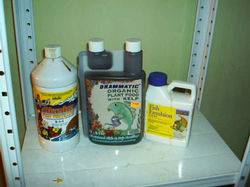Seaweed contains all major and minor plant nutrients, and all trace elements; alginic acid; vitamins; auxins; at least two gibberellins; and antibiotics.
Of the seaweed contents listed after nutrients and trace elements, the first, alginic acid, is a soil conditioner; the remainder, if the word may be forgiven in this context, are plant conditioners. All are found in fresh seaweed, dried seaweed meal and liquid seaweed extract -- with the one exception of vitamins: these, while present in both fresh seaweed and dried seaweed meal, are absent from the extract.
It is known that plants treated with seaweed products develop a resistance to pests and diseases, not only to sap-seeking insects such as red spider mite and aphides, but also to scab, mildew and fungi. Such a possibility may seem novel, but it is in keeping with the results of research in related fields. The control of plant disease by compounds which reduce or nullify the effect of a pathogen after it has entered the plant is an accepted technique.
Of the seaweed contents listed after nutrients and trace elements, the first, alginic acid, is a soil conditioner; the remainder, if the word may be forgiven in this context, are plant conditioners. All are found in fresh seaweed, dried seaweed meal and liquid seaweed extract -- with the one exception of vitamins: these, while present in both fresh seaweed and dried seaweed meal, are absent from the extract.
It is known that plants treated with seaweed products develop a resistance to pests and diseases, not only to sap-seeking insects such as red spider mite and aphides, but also to scab, mildew and fungi. Such a possibility may seem novel, but it is in keeping with the results of research in related fields. The control of plant disease by compounds which reduce or nullify the effect of a pathogen after it has entered the plant is an accepted technique.
Last edited:




